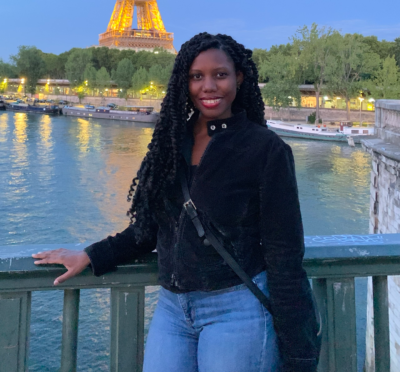“When I was a student at FIT, I didn’t even know my job existed,” says Jo-Well Paupaw, a senior writer and producer for Black Entertainment Television. An Advertising and Marketing Communications alumna, Paupaw conceptualizes, writes, and produces campaigns for BET’s TV shows, movies, specials, and social impact and brand image campaigns.
Recently, Paupaw described for Hue the process of making a promo to advertise BET’s program, American Injustice: The Fight for Police Reform. The 30-second spot required exacting precision and attention to detail. Watch the promo, above; then read the fascinating account of how Paupaw developed it.

During my time at BET, I’ve produced campaigns for The Bobby Brown Story, which brought in 13.4 million viewers the week of its premiere; American Soul: The Untold Story of Soul Train; Black History Month; and Black Girls Rock!
As a senior writer/producer, I write, produce, and supervise the edit. For American Injustice, the goal for the promo was to convey the crisis of police brutality and capture the anger, passion, grief, and frustration of the protesters. I worked with the supervising senior editor at BET. He’s amazing at what he does. My job was to write the promo and piece together the story with video footage, sound bites, and lines from Soledad O’Brien. I also selected the music and supervised the audio mix session. As the producer, I give the editor direction on how I want the spot to come together.
I collected hundreds of photos and videos for each section of the promo and told the editor which footage and images I wanted to use. The direction I gave was to create a fast montage with a flutter-style edit. How long a shot or image stayed on screen was significant to developing the right rhythm and pacing. The music was also a driving factor.
I selected each image based on how it would move the story forward. For example, the image of the protester with the “I can’t breathe” T-shirt, standing alone, hands behind their back, facing off with a group of police officers in riot gear, is emblematic of how Black people often feel they are under siege in this country, especially by law enforcement. This emphasizes the need for police reform.
At the top of the promo, I wanted to show victims of police brutality, so I gave my editor timecode of the shots I selected. (Timecode is a time assigned to a frame in a video. We use it like a timestamp to synchronize audio and label footage.) After that, we established who was responsible for those murders. We built a section with police images and videos to create the “sworn to protect us” portion, followed by the Black Lives Matter murals across the country, to reiterate that police brutality and racial injustice is a national crisis.
Taking a knee is an important gesture in the BLM movement, so that definitely needed to be included. We started it with an image of Colin Kaepernick, who first knelt during the national anthem in 2016, and was condemned for it. The sign that reads “Do you understand yet?!” is a testament to that. I looked over a ton of photos to find a range of people who were now taking a knee in solidarity.
However, this movement is bigger than just protest, so we addressed policy. It was important to have the “defund the police” section. Yet, there are also photos of lawmakers and Philonise Floyd, George Floyd’s brother, testifying on Capitol Hill. Since this is a systemic issue, we used images like Lady Justice and the printing of money with the Founding Fathers on it. Though they appear quickly, those images symbolize how racial injustice is embedded in and funded by U.S. institutions.
We decided to end the promo with the “I can’t breathe” section. “I can’t breathe”—the last words spoken by George Floyd, Eric Garner, and so many others–is a metaphor for the systemic racism Black people experience in the form of police brutality. It was important to end the last shot of the promo with a young Black man crying out for change. We hear a crowd of people shout, “Don’t shoot!” This is a rallying cry linked to the death of Michael Brown, but has also become a statement in opposition to the excessive force used by police officers. “Don’t shoot!” are often the last words uttered before a Black life is lost to police brutality. The victims can’t speak for themselves; so we hear the crowd speaking for them.
In this 30-second promo we sourced hundreds of photos and videos and used over 35 in the final product. However, it was important that each image, no matter how quickly it flashed on the screen, was significant to the story.
